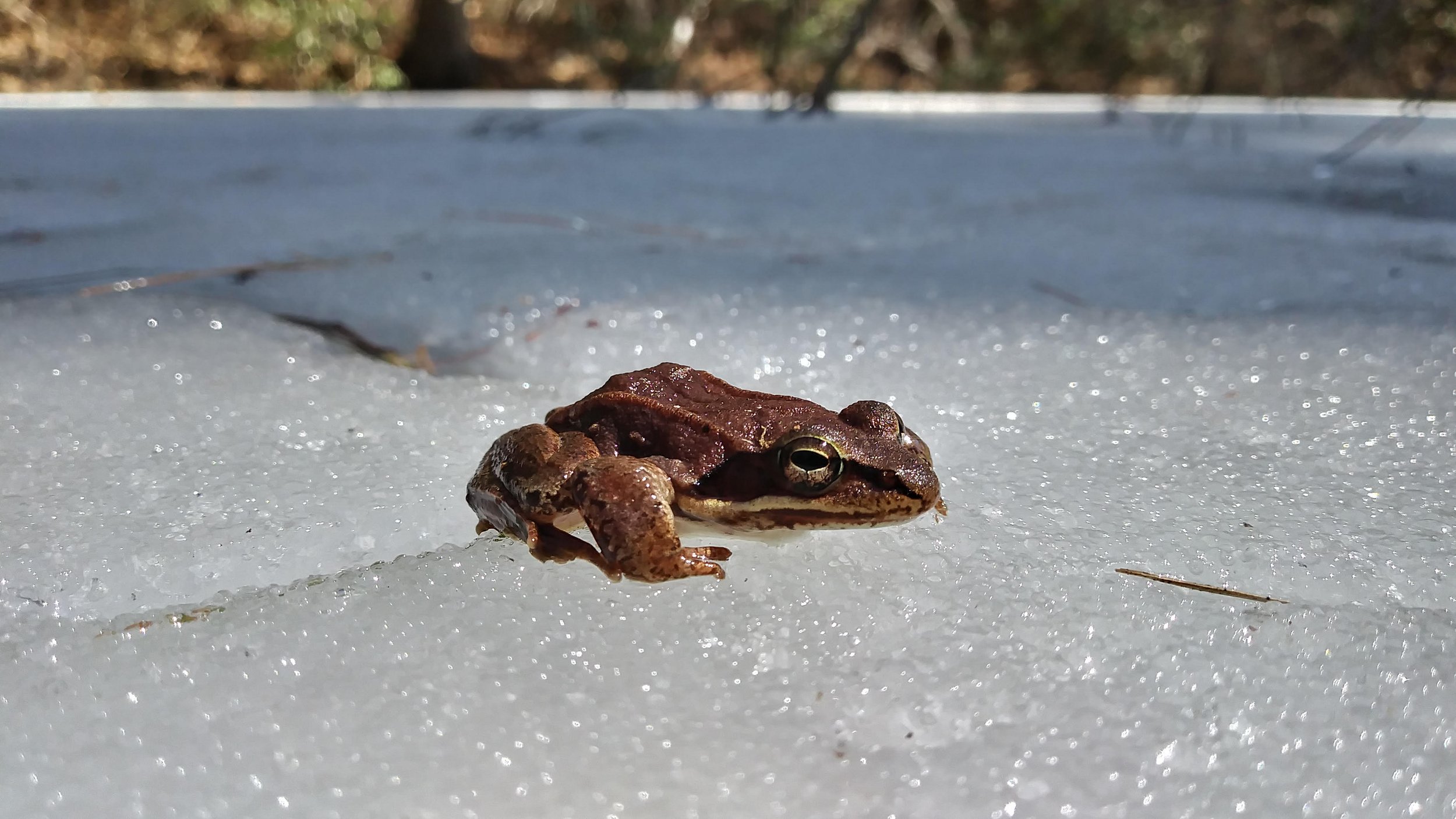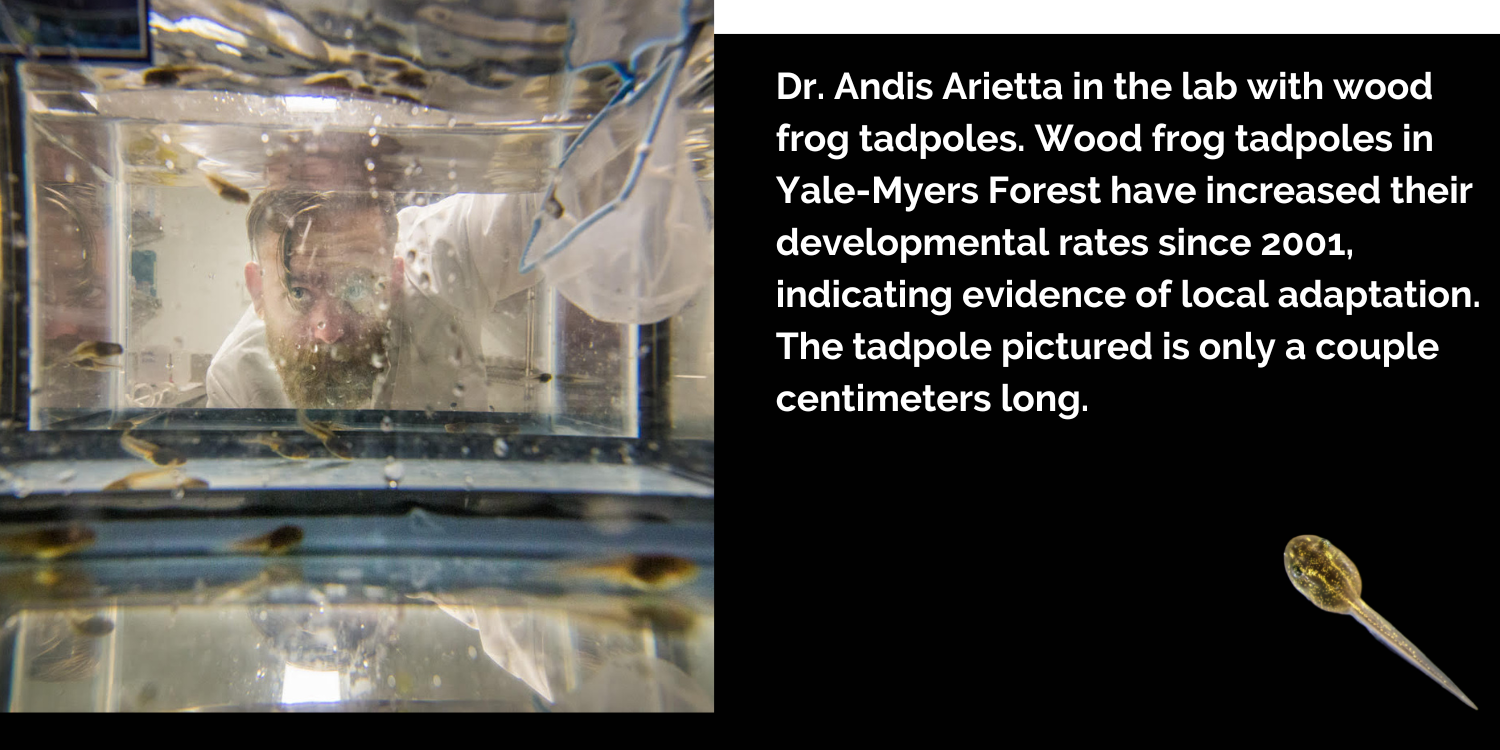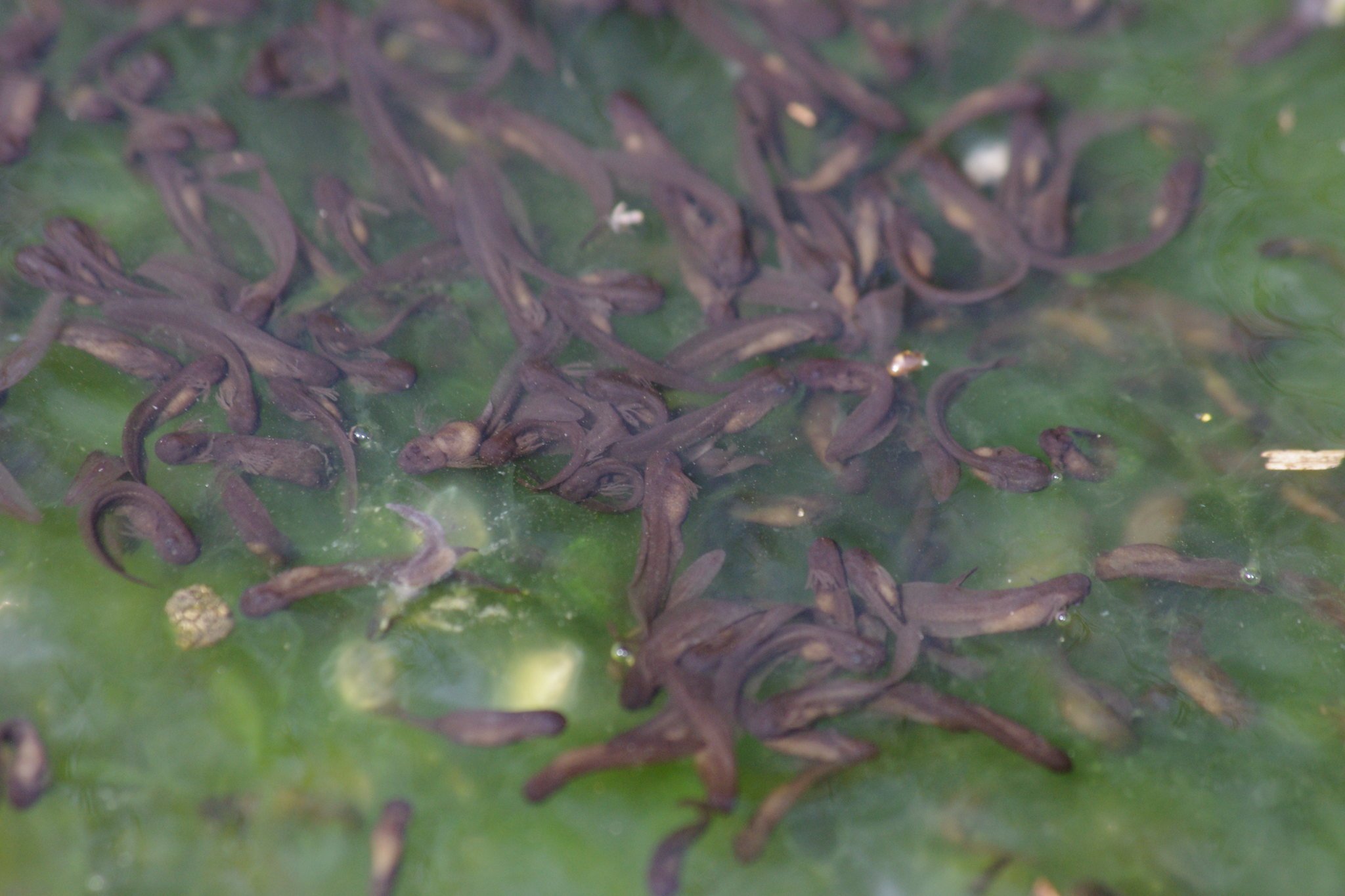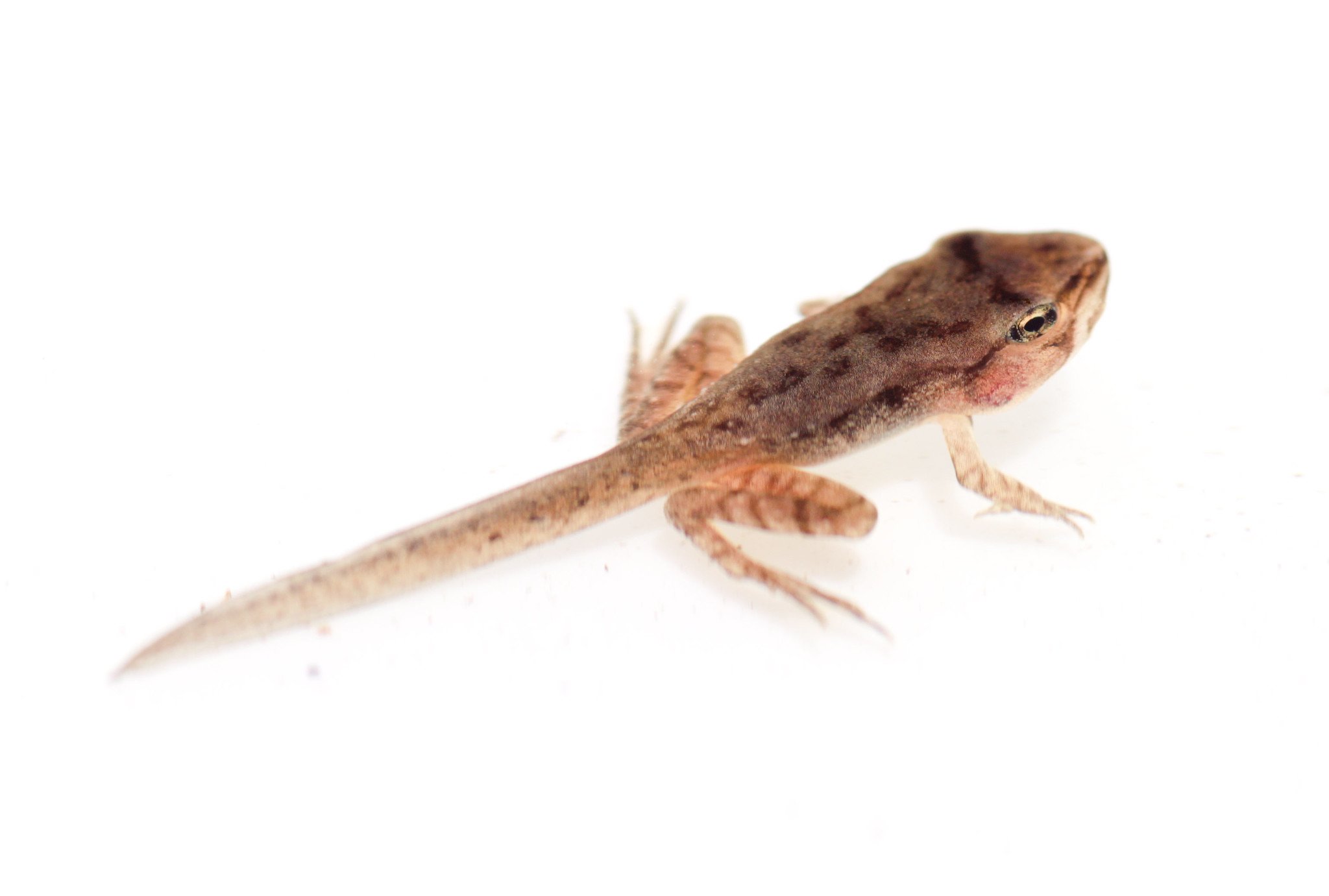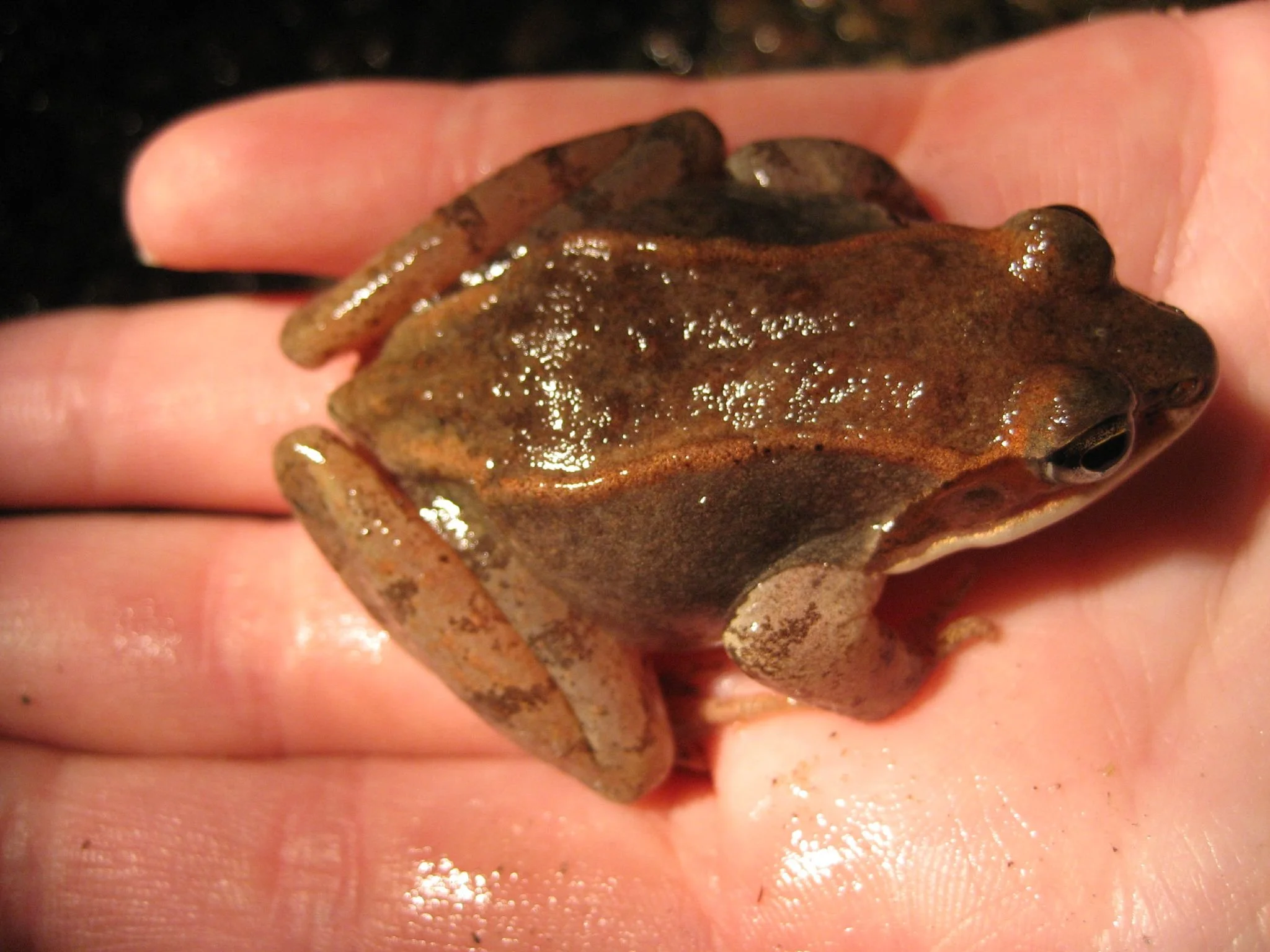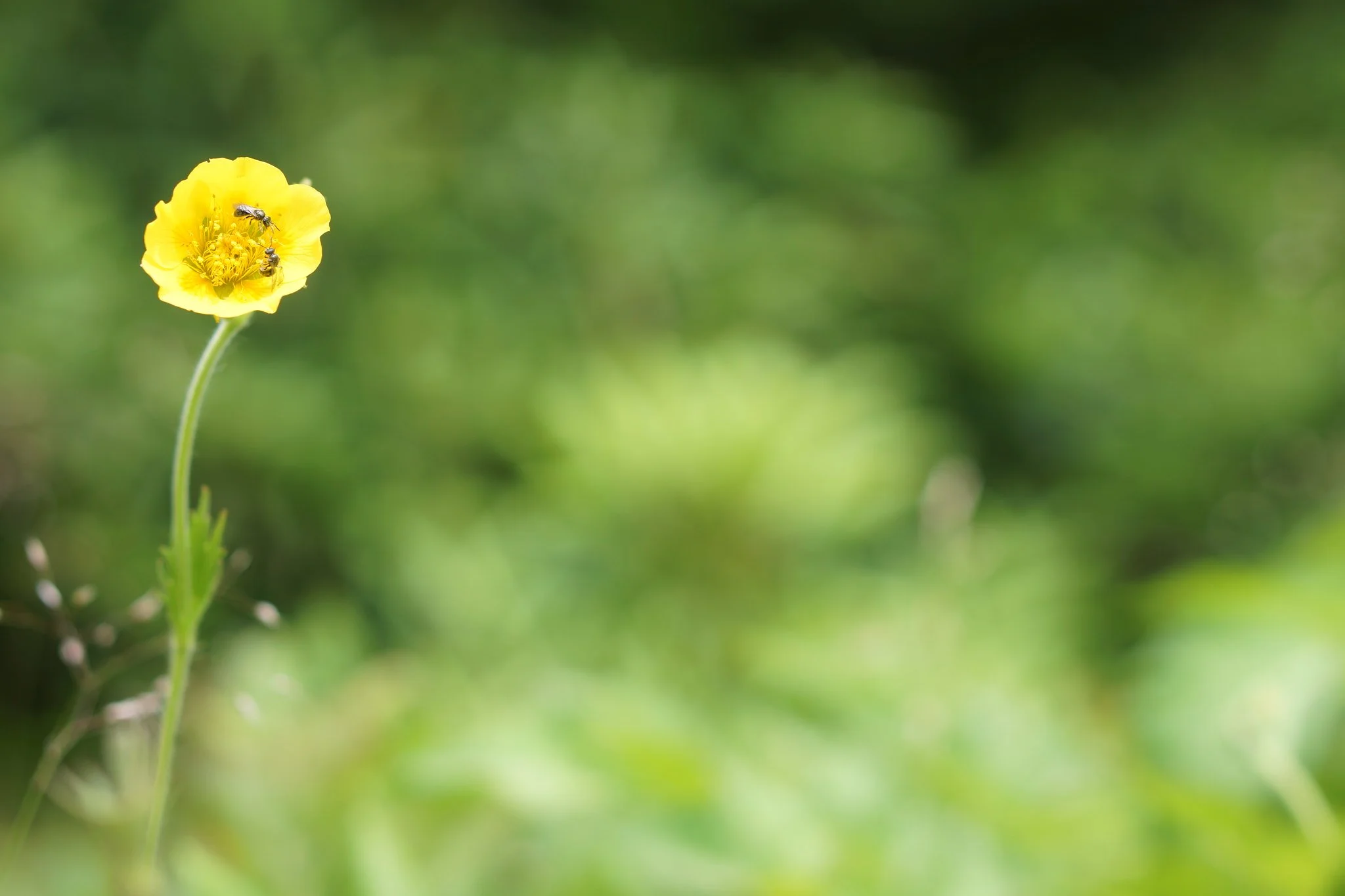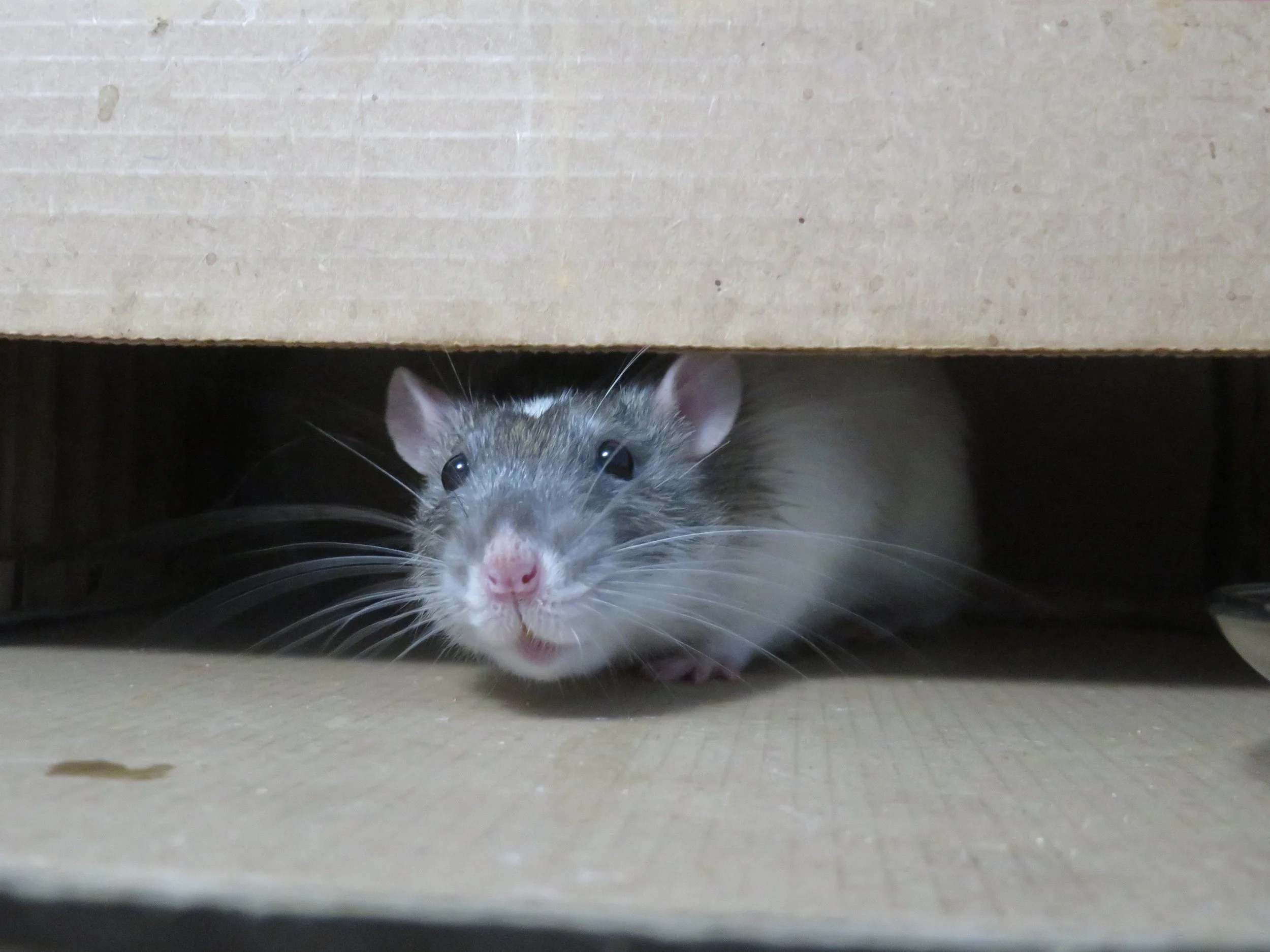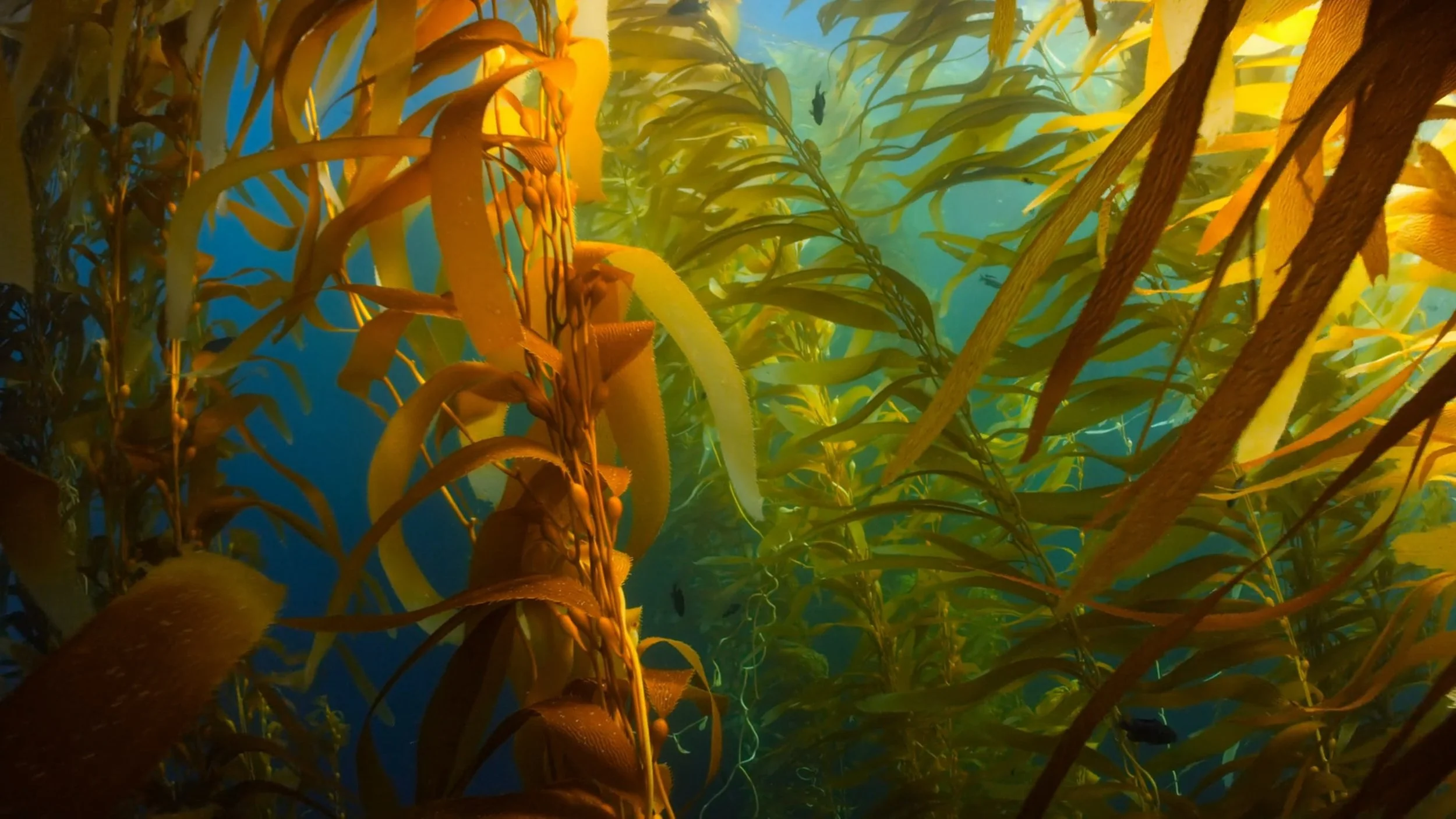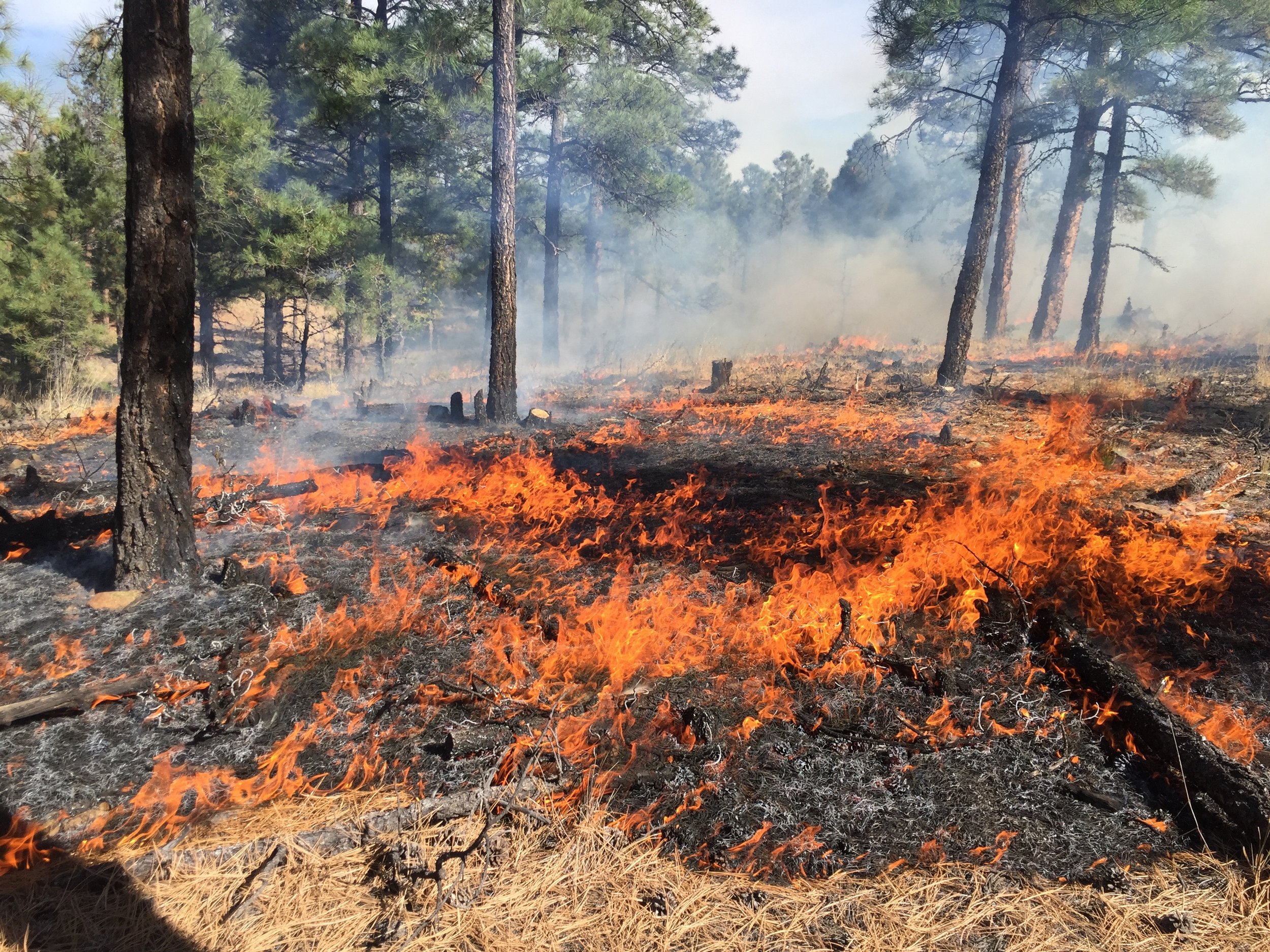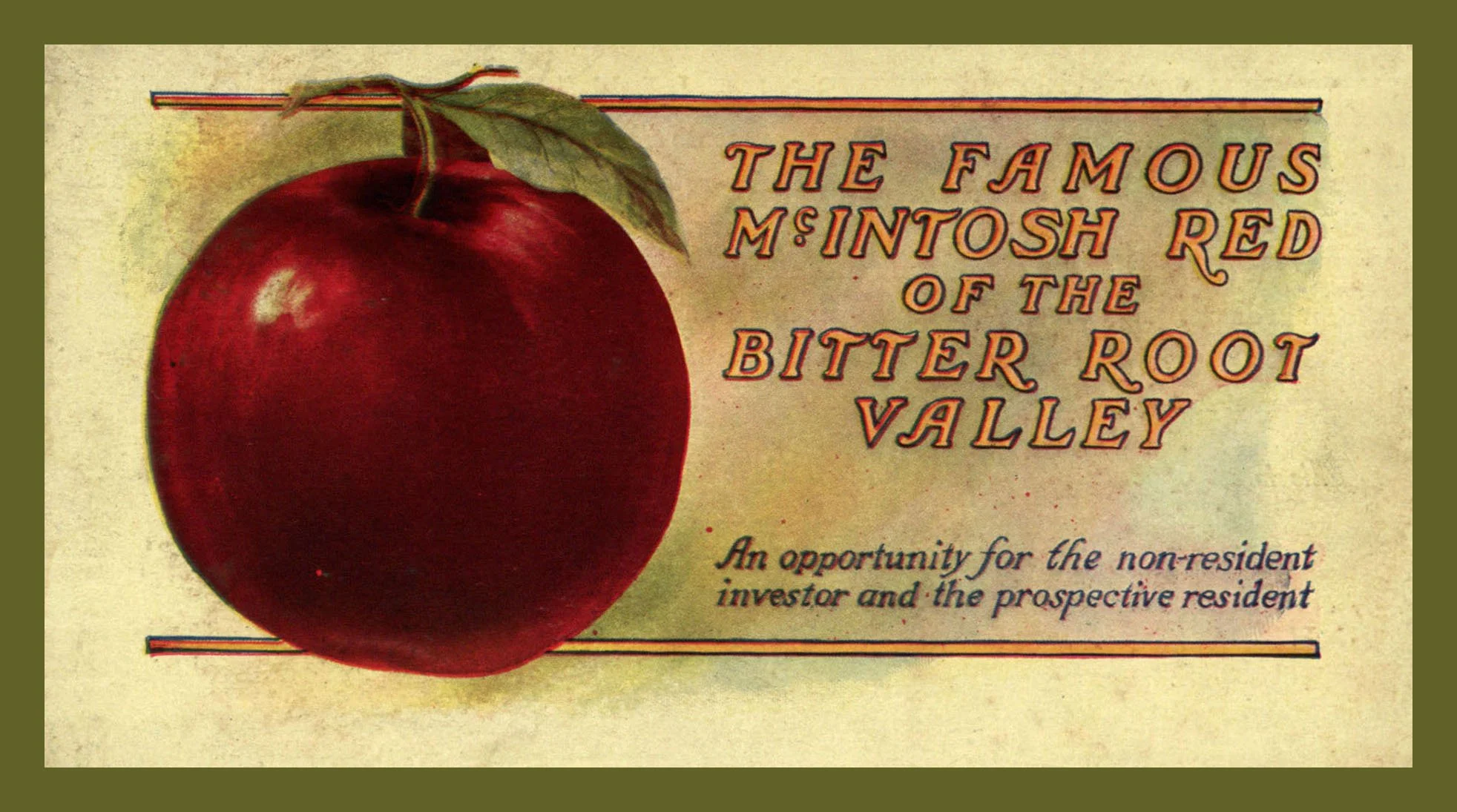In a Warming World, Freeze-Tolerant Frogs Face New Threats
Can wood frogs adjust to thawing ice and drying ponds?
by Megan Reich
December 6, 2022
In early March of 2019, northeastern Connecticut’s Yale-Myers Forest is blanketed in white. Amid the stillness, a speckled brown wood frog stirs atop a sparkling frozen pond. Bright and early to his breeding site, he waits for the ice underneath to thaw.
The wood frog’s patience pays off as the pond ice melts. Other males of his kind will soon join him, hoping to snag a mate. Once female wood frogs deposit their eggs, evolutionary ecologist Andis Arietta and his research teammates don rubber hip waders and venture into the pond waters — chilly for humans, but perfectly comfortable for a frog capable of freezing up to 70% of its body fluids.
“When you’re basically standing in an ice bath for the entire day, it gets pretty cold,” said Arietta, who studied wood frogs for his dissertation at Yale University. For 20 years starting in 2000, Arietta and other researchers in David Skelly’s amphibian ecology lab at Yale dutifully monitored Connecticut’s wood frogs, tracking population sizes, egg counts, and egg-laying dates of over 50 wood frog populations in Yale-Myers Forest.
Yale-Myers Forest, Connecticut
Yale-Myers Forest signs and northern entrance to the Nipmuck Trail near Bigelow Hollow State Park. Image credit: Morrow Long, CC BY-SA 2.0, via Wikimedia Commons.
Registering an estimated total increase of 1.1 degrees Celsius since 1980, the annual temperature in Yale-Myers Forest has been gradually warming, according to Arietta’s 2020 study published in Ecography. Climate change causes earlier springs in many parts of the world; some animals have begun to shift spring behaviors like breeding and egg-laying to earlier in the season.
But the wood frog, a common, widespread North American species, has been adapting in a different way in Connecticut — emerging later, not earlier in the season. Wood frog embryos and tadpoles have had less time to develop before their ponds dry out for the summer. Arietta’s team wanted to find out whether wood frog embryos and tadpoles could adjust to a shrinking development window. If not, climate change may outpace the wood frogs’ ability to adapt and evolve.
Most amphibians burrow deep underground for the winter, but wood frogs are freeze tolerant, allowing them to hibernate close to the soil surface and emerge early in the spring. Within their winter hiding places — under a leafy tree base, inside a rotten log — the breath and heartbeat of a wood frog come to a pause. Cryoprotectants, compounds that include glycerol and glucose, accumulate in their blood. These cryoprotectants reduce ice formation in wood frogs’ organs, stabilize their proteins and membranes, and maintain their skeletal muscle metabolism.
“It’s one of the coolest things about them,” remarked Arietta, who is fascinated by wood frogs’ freeze-tolerant abilities. “Because they can do it, it really opens up the doors for where they can expand their range.” Wood frogs thrive from the green slopes of the southern Appalachian Mountains to the tundra of northern Canada, allowing scientists to compare their responses to climate change across vastly different conditions.
“When you’re basically standing in an ice bath for the entire day, it gets pretty cold.”
Typically, amphibians breed earlier in response to warming temperatures caused by climate change, similar to advancements in first flowering dates, butterfly migratory arrivals, and leaf emergence in trees. But for wood frogs, the story isn’t the same across their vast range. Even though average temperatures in Connecticut have been increasing, Arietta and his collaborators found that since 2000, the estimated breeding time of wood frogs in Yale-Myers Forest has shifted later by 2.8 days.
“After confirming that wasn’t just an error in our math, we started digging into it more,” said Arietta. It turns out that in Connecticut, most warming has been occuring in the summer and less during spring, potentially putting less pressure on wood frogs to jump-start their breeding. Arietta’s team also found that snow has been accumulating later and persisting longer into the spring, which delays pond ice melting. Because wood frogs can’t breed on snow-covered ponds, they ended up breeding later.
Image credit: AZ Andis Arietta
About three weeks after the research team finishes counting the wood frogs’ clusters of translucent eggs, the tadpoles hatch. Wood frogs lay their eggs in ephemeral ponds that hold water for only a portion of the year. That way, tadpoles can avoid predators like fish and bullfrogs that frequent permanent water bodies. But when tadpoles hatch later in the season, they have less time to develop into adults before their ponds dry out.
The length of time a temporary pond is wet is called a pond’s hydroperiod. In Yale-Myers Forest, hydroperiods are narrowing due to warmer temperatures and less precipitation in the summer.
“Wood frogs are getting squished from both sides of the seasonal window,” said Arietta. “To avoid becoming tadpole-shaped raisins at the end of the season, these tadpoles have to develop really quickly.”
Adapting under pressure is not new to wood frogs. A 2020 study published in Global Change Biology found that winter climate warming is not likely to pose a threat to wood frogs’ survival throughout their range. One way wood frogs cope with different types of winters across their range is by burrowing at different depths in the ground. “The ideal depth varies between different populations,” explained Megan Fitzpatrick, a wetland wildlife scientist at the Minnesota Department of Natural Resources and lead author of the Global Change Biology study. “The deeper they go, the warmer they stay, but that bumps up their energy requirements.” Wood frogs hibernating at shallower depths don’t need to use as much energy, but they are more at risk of accumulating lethal ice content in their bodies.
Adult wood frogs have found ways of coping with warmer winters. But can wood frog tadpoles adapt to drier summers? That’s what Arietta and his research team wanted to find out next.
As part of a 2021 study in Evolution, Arietta’s lab measured developmental rates of wood frog embryos from selected ponds in Yale-Myers Forest. Developmental rates were based on estimated embryonic periods, or the amount of time between oviposition and hatching. The scientists found that compared to 2001, embryos from the same ponds have increased their developmental rates by 14% to 19%, and embryonic periods have shortened by about 1.7 days. The results indicate that adaptation might indeed be taking place.
“We see the increased developmental rate as evidence for evolution on a microgeographic scale,” said Arietta.
Arietta’s 2021 study showed that wood frogs do have the capacity to respond to environmental change, but it’s not limitless. While faster development could help a wood frog survive through its first summer, it may also have negative long-term impacts on its ability to survive and reproduce as an adult. In a 2021 study in Oecologia, for example, Ohio University researchers observed that adult frogs that managed to develop in ponds with shorter hydroperiods failed to grow as fast or large as frogs that developed in ponds with longer hydroperiods.
“There’s a trade-off at play,” explained Jon Davenport, a herpetologist at Appalachian State University. By developing faster, wood frogs can get out of their ponds before they dry up, but it also means they end up being smaller as adults.
“Smaller wood frogs are less likely to survive to the next year,” said Davenport. Bigger wood frogs, on the other hand, are more reproductively fit, which means they can potentially produce more eggs.
Davenport studies wood frogs living at the edge of their ranges in southern North Carolina and the northern Canadian sub-Arctic. Over the years, Davenport’s concern has grown while watching trees sink under the melting permafrost of the sub-Arctic wetlands he studies, with some ponds “drying faster than they’ve ever dried,” he said.
“Wood frogs on the southern end of the range are used to longer periods of water in their ponds,” remarked Davenport. “The rate of drying here may be slow enough for them to adapt, but the rate is so fast in the Arctic, it's beyond what they can respond to.”
Over one-third of amphibians are listed by the International Union for Conservation of Nature as threatened, endangered, or critically endangered. Habitat destruction, disease, pollution, and now climate change contribute to their decline. But despite such rapid changes to their environments, the hardy wood frogs will likely not join the list, say experts.
Image credit: Placeuvm, CC BY-NC-SA 2.0, via Flickr.
“I like to call them frozen hockey pucks. They’re resilient little critters,” said Davenport, who explained that the way wood frogs respond to climate change can serve as a baseline of comparison for other more sensitive species. “If you have a common species, and if it's struggling to keep up with environmental change, that’s a red flag for species that are more sensitive,” he said.
As scientists continue to study the ways that regional impacts of climate change affect species differently across their geographical ranges, Arietta anticipates seeing less of a “gloom and doom” attitude in the conservation world. While wood frogs may be able to adapt to warming temperatures and drying ponds fast enough in some parts of their ranges, they may not in others.
“We’re moving towards a more nuanced picture,” said Arietta. “Some species are going to get hit harder than others, but we’re not going to lose everything.”
Next year, just as the pond ice is beginning to melt, a chorus of duck-like clucks will be the first spring calls heard in Yale-Myers Forest. Arietta will be there, watching as the dutiful wood frogs show up in the cold to create a future generation that will follow them.
Megan Reich
Megan Reich is a Minneapolis-based science communicator interested in strengthening relationships among humans, non-humans, and places. Her current work focuses on climate change, ecology, water resources, and community-empowered change. Megan received a Bachelor of Science in biology from University of Puget Sound and recently completed a Master of Arts in science writing from Johns Hopkins University.

